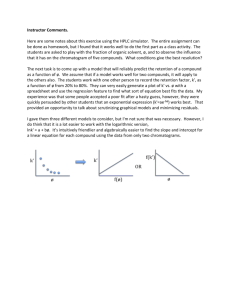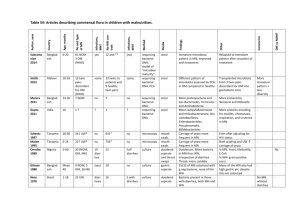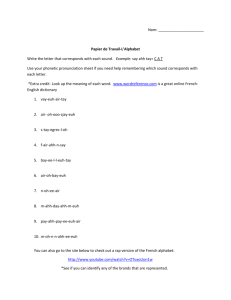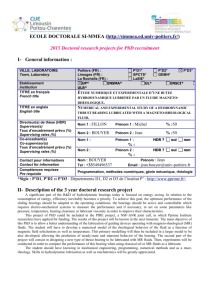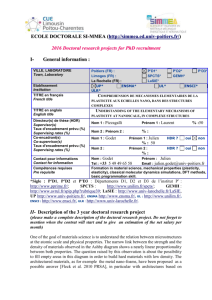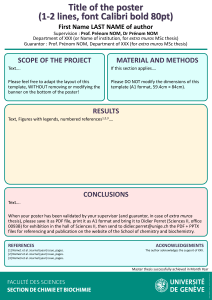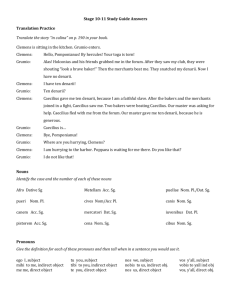On the Linking Construction V-
advertisement
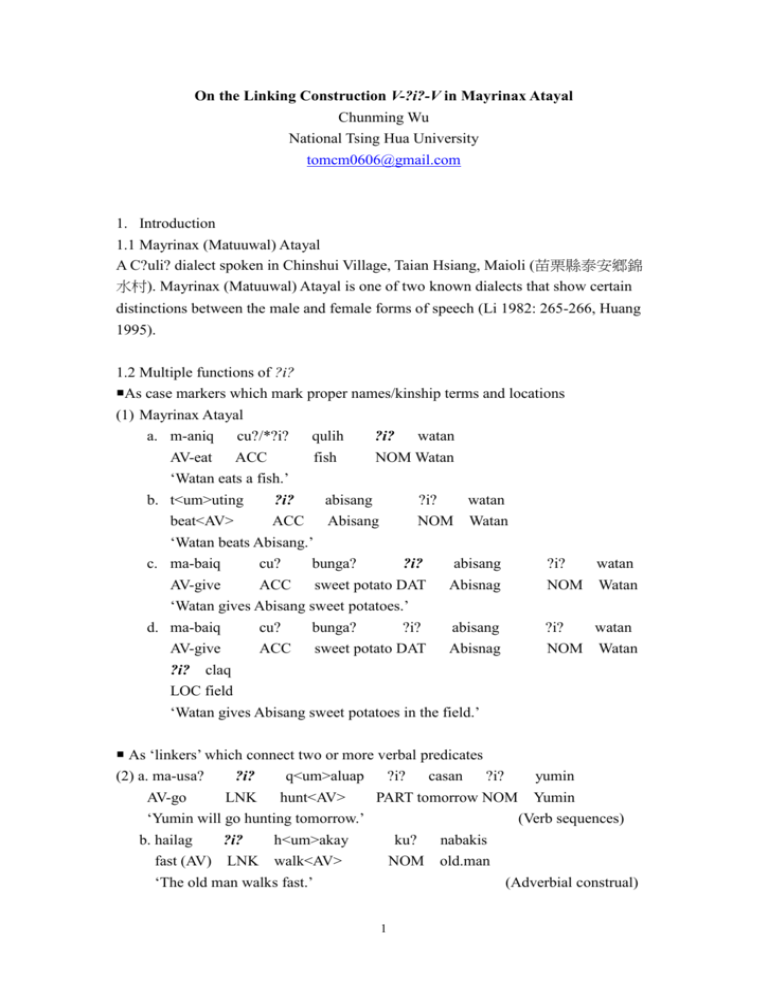
On the Linking Construction V-?i?-V in Mayrinax Atayal Chunming Wu National Tsing Hua University tomcm0606@gmail.com 1. Introduction 1.1 Mayrinax (Matuuwal) Atayal A C?uli? dialect spoken in Chinshui Village, Taian Hsiang, Maioli (苗栗縣泰安鄉錦 水村). Mayrinax (Matuuwal) Atayal is one of two known dialects that show certain distinctions between the male and female forms of speech (Li 1982: 265-266, Huang 1995). 1.2 Multiple functions of ?i? As case markers which mark proper names/kinship terms and locations (1) Mayrinax Atayal a. m-aniq cu?/*?i? qulih ?i? watan AV-eat ACC fish NOM Watan ‘Watan eats a fish.’ b. t<um>uting ?i? abisang ?i? watan beat<AV> ACC Abisang NOM Watan ‘Watan beats Abisang.’ c. ma-baiq cu? bunga? ?i? abisang AV-give ACC sweet potato DAT Abisnag ‘Watan gives Abisang sweet potatoes.’ d. ma-baiq cu? bunga? ?i? abisang AV-give ACC sweet potato DAT Abisnag ?i? claq LOC field ‘Watan gives Abisang sweet potatoes in the field.’ ?i? watan NOM Watan ?i? watan NOM Watan As ‘linkers’ which connect two or more verbal predicates (2) a. ma-usa? ?i? q<um>aluap ?i? casan ?i? yumin AV-go LNK hunt<AV> PART tomorrow NOM Yumin ‘Yumin will go hunting tomorrow.’ (Verb sequences) b. hailag ?i? h<um>akay ku? nabakis fast (AV) LNK walk<AV> NOM old.man ‘The old man walks fast.’ (Adverbial construal) 1 c. ki ?i? m-a-usa? ?i? bari ?i? watan ?i? casan probably LNK AV-IRR-go LOC Miaoli NOM Watan FUT tomorrow ‘Watan will probably go to Miaoli tomorrow.’ (Modal construal) ?i? connects verbal predicates and Future temporal expressions (Huang 1995). (3) Mayrinax a. pa-pumuwa? ?i? casan cu? raramat ?i? watan IRR-plant (AV) tomorrow ACC vegetable NOM Watan ‘Watan will plant vegetables tomorrow.’ b. m-a-usa? ?i? pilag ?i? watan AV-IRR-go year NOM Watan ‘Watan will leave next year.’ 1.3 Research questions: What constructions does the linker ?i? involve? How is the linker ?i? structurally represented—what grammatical status does it hold of? 1.4 Organization Section 2: previous studies regarding Formosan linkers Section 3: Structures of Linking Constructions Section 4: Linker in subordination Section 5: Conclusion 2. Previous Studies in Formosan Languages Huang (1997): Linking constructions as in (4-5) can be treated on a par with Serial Verb Construction (SVC) since the constructions manifest events sharing a common agent (experiencer) and being coded by two or more verbs in sequence. (4) Mayrinax Atayal (Huang 1997:59) a. m-a-usa? ?i? q<um>aluap ?i? casan ?i? yumin AV-IRR-go LNK hunt<AV> PART tomorrow NOM Yumin ‘Yumin will go hunting tomorrow.’ b. lihka? ?i? h<um>akay ku? nabakis fast (AV) LNK walk<AV> NOM old.man ‘The old man walks fast.’ 2 (5) Paiwan (Huang 1997:59) a. uri= vaik=aken a s<em>a-taihuku a v<en>eli IRR=leave (AV)=1S.NOM LNK go.to<AV>-Taipei LNK buy<AV> tua tjamay OBL vegetable ‘I will leave for Taipei to buy vegetables.’ Tang (1999): in Paiwan Linker a (as in (5a)) in Paiwan serves as a non-finite complementizer. The embedded verb is subject to AV-only restriction and cannot be inflected for Tense/Aspect/Modality. Chang (2006): in Paiwan Linker a in Paiwan does not only serve as a non-finite complementizer. (6) Paiwan (Chang 2006:6) a. ini=ka=aken a na-k<em>an tua vurasi NEG=KA=1S.NOM LNK PERF-eat<AV> OBL sweet.potato ‘I did not eat sweet potatoes.’ b. ini=ka=aken a uri=k<em>an tua vurasi NEG=KA=1S.NOM LNK IRR=eat<AV> OBL sweet.potato ‘I will not eat sweet potatoes.’ Permutation phenomenon is found in some linking constructions (repetitive, quantifying, durative, causative multi-verb constructions) (7) Paiwan a. t<em>ekel a m-umal tua vava ti palang drink<AV> LNK AV-again OBL wine NOM Palang ‘Palang drinks wines again.’ b. m-umal a t<em>ekel tua vava ti palang AV-again LNK drink<AV> OBL wine NOM Palang ‘Palang drinks wines again.’ Tsai (2007): in Tsou, Squliq Atayal and Amis Conjunctive Reduction: In Atayal, Tsou, and Amis a conjunction (Linker) has turned into a complementizer for either adverbial clauses or complement clauses, a process dubbed as “conjunctive reduction”. 3 The Reduction Schema (Tsai 2007: 17) (8) Adv + V ← Adv-MM + V ← V Conj V → V [Comp V] → V + V Amis Squliq Atayal Tsou “Complementization”: the conjunction has been grammaticalized as a complementizer, as in Squliq Atayal and Tsou, “Adverbialization”: the conjunction becomes optional due to the loss of its core semantic property of marking additive or sequential relationship in this particular configuration, as in Amis. 3. Structures of Linking Constructions 3.1 Control 3.1.1 Subject control The initial verbs in root clauses bear major morphosyntactic markings (Voice, TAM inflection, pronominal clitics) as in (9). The embedded verbs are subject to AV-only restriction. (9) a. m<in>usa?=ta? [CP[C’?i?[TP q<um>aluap AV<PERF>-go=1P.NOM LNK hunt<AV> ‘We went hunting wild pigs yesterday.’ b. m-antalam-ay=ta? [CP[C’?i?[TP AV-try-PROJ=1P.NOM LNK ‘Let’s try to shoot wild pigs.’ cu? bauwak cuhisa? ACC pig yesterday c<um>bu? shoot<AV> cu? ACC bauwak pig The subject control construal has its NAV counterpart. (10) Mayrinax a. ?<in>usal-an=nia? ?i? q<um>aluap ku? bauwak cuhisa? go<PERF>-LV=3S.GEN. LNK hunt<AV> NOM wild.pig yeaterday ‘He went hunting the wild pigs yesterday.’ b. ?antalam-aw=ta? i ?i? try-PROJ.LV=1P.GEN LNK ‘Let’s try to shoot the wild pigs.’ c<um>bu? shoot<AV> ku? bauwak NOM wild.pig The bauwak can be marked as ACC in the embedded clause as in (11). This suggests that ?i? occupies in non-finite C position>> PV Main verb cannot assign nominative case through CP. 4 (11) Mayrinax a. [?<in>usal-an=nia? i [CP[C’?i?[TP Pro i q<um>aluap cu? bauwak]]] cuhisa?] go<PERF>-LV=3S.GEN. LNK hunt<AV> ACC wild.pig yeaterday ‘He went hunting wild pigs yesterday.’ b. [?<in>anatalam-an=ta? [CP[C’?i?[TP Pro i c<um>bu? cu? bauwak]]]] try<PERF>-LV=1P.GEN LNK shoot<AV> ACC wild.pig ‘We have tried to shoot wild pigs.’ 3.1.2 Object control V1 must be in NAV and the embedded V2 observes AV-only restriction (12) Mayrinax Atayal a. siwal-an=mi? i (?i?) allow-LV=1S.GEN NOM watan [CP[C’?i?[IP Pro i q<um>aluap/*pa-qaluap/ Watan LNK hunt<AV>/IRR-hunt/ *qaluap-un]]] Hunt-PV ‘I allow Watan to go hunting.’ Object control construal does not have its AV counterpart (cf. Pivotal construction in Huang 1995). (13) Mayrinax Atayal a.*s<um>iwal=ci? i (?i?) allow<AV>=1S.NOM ACC ‘I allow Watan to go hunting.’ watan [CP[C’?i?[IP Pro i q<um>aluap... Watan LNK hunt<AV> In control construction the linker ?i? may be realized as a non-finite complementizer introducing non-finite clauses. 3.2 Raising 3.2.1 Adverbial verb construction (AVC) AVC as Raising instead of SVC (Chang 2007, Li 2006) AVC violates SVC conditions (Chang 2007) a. The linkerless condition b. The lexical verb condition c. The Nonselection condition d. The (semantic) argument-sharing condition 5 Mayrinax AVC a. Adverbial verbs are fully inflected. b. AV-only restriction on the lexical verbs c. Syntax-semantic mismatch (14b) d. Linker ?i? bypasses argument raising. (14) a. [m-?an(a)-bibui AV-do-quickly [ ?i? c<um>aqis LNK sew<AV> cu? siatu?/situing] ku? OBL clothes NOM knairil ] woman ‘The woman quickly sews some clothes.’ b. [?an(a)bibuy-un na? knairil(x) do-quickly-PV GEN woman ti] ku? [ ?i? c<um>aqis (tx) LNK sew<AV> siatu?i ] NOM clothes ‘The woman quickly sews the clothes’ (embedded object raising) (15) a. m-ti-hiya-hiyaw=ci? ma-niq AV-eat-RED-slow=1S.NOM (LNK) AV-eat ‘I eat fish slowly.’ cu? OBL b. pa-pti-hi-hiyaw-un=mi? ma-niq CaRED-eat-RED-slow-PV=1S.GEN (LNK) AV-eat qulih fish ku? NOM qulih fish ‘I will eat the fish slowly.’ e. Applicativization (16) a. m-(?a)na-pusal ?i? c<um>aqis ni? watan cu? AV-do-two LNK sew<AV> OBLWatan ACC ‘Tapas sews clothes twice for Watan.’ siatu? clothes ?i? tapas NOM Tapas b. si-?(a)na-pusal ?i? c<um>aqis ni? tapas cu? siatu? ?i? watan BV-do-two LNK sew<AV> GEN Tapas OBL clothes NOM Watan ‘Tapas sews clothes twice for Watan.’ 6 Verb classifying system (cf. Chang 2009 in Tsou) a. ?na- (Huang 2008 p.c.) on adverbial verbs denotes general activities. (17) m-(?)na-hmuhmut ?i? AV-do-randomly LNK m<um>uwa? cu? bunga? ?i? abisang plant<AV> OBL sweet potatoes NOM Abisang ‘Abisang plants sweet potatoes randomly.’ l<um>ngui swim<AV> kabalay do (AV) cu? OBL siatu? clothe m-atas AV-write m-aiq AV-give cu? OBL pila? money c<um>aqis sew<AV> b. Specialized Activities (18) a. m<in>-ti/(*?na)-hiyahiyaw ?i? ma-niq AV<PERF>-eat-slow LNK AV-eat ‘Tali ate (cooked rice) slowly.’ b. sgi/(*m-?na)-hiyahiyaw ?i? drink-slow (AV) LNK ‘Watan drinks wines slowly.’ m-nubuag AV-drink c. m-akna-bibui=ci? AV-walk by-fast=1S.NOM (LNK) ‘I walk fast.’ d. psi-hmuhmut=ci? shoot-random (Av)=1S.NOM (LNK) ‘I shoot randomly.’ cu? OBL cu? OBL h<um>akai walk<AV> c<um>bu? shoot<AV> 7 mami? ?i? tali? cooked.rice NOM Tali quwau wine ?i? watan NOM Watan e. maksi-hmuhmut ?i? Sleep-randomly (AV) LNK ‘He sleeps randomly.’ maqilaap/maqailup sleep ?i? hiya? NOM 3S c. Semantic agreement rather than affixal concord in form (Li 2008, 2009); Compare: (19) Bunun (Nojima 1996: 16, 18) a. kis-aus-a=s mabananaz=tia kis-laupa LP (stab)-immediately man=NPV.that LP (stb)-stab ‘Immediately after that, the man stabbed (the woman).’ b. pit-utmag-un ma-pit’ia tastu-tilas LP (cook)-carelessly AO-cook one-uncooked.rice ‘(She) carelessly cooked a grain of rice in one piece, without breaking it apart.’ (20) Kanakanavu a. ku-vula=ku k<um>a-kun uru Eat-fast=1S.NOM RED<AF>-eat cooked.rice ‘I eat (cooked rice) fast.’ b. ca-un-un=maku roast-again-PF=1S.GEN ‘I roasted the fish again.’ c<um>a-capa roast<AF> vutukuru fish (21) Saaroa (Li 2008:1) a. hli-pahlu-muamurari=cu=aku pahlu-sahli. PFV-AV.LP(sing)-slowly=COS=1SG.NOM AV.LP(sing)-song ‘I sang songs slowly.’ b. taku-care-caremi=cu=aku taku-’i’iare. AV.LP(work)-RED-ache=COS=1SG.NOM AV.LP(work)-work ‘I fell ill from working.’ ?na and other classifying prefixes like pti-, sgi- seem to occur in the same position. However, when stacking adverbial verbs, ?na is structurally located higher than other classifying prefixes (Chang 2009: pc). 8 (22) Mayrinax a. m-na-ri?a-ri?ax ?i? sgi-hmuthmut AV-Do-RED-day (often) LNK drink-randomly cu? quwau ?i? watan Watan wine NOM Watan ‘Watan often drinks wines randomly.’ ?i? m-nubuwag LNK AV-drink Structure of AVC ?i? as strong T which bypasses clitic movement and argument raising. The Strong T is c-commanded by the voice category. Voice head can penetrate the embedded TP assigning Nominative case to the embedded patient and at the same time trigger clitic climbing from the embedded TP. Fig.1 Structure of (15b) TP T’ ku? T (Ca-RED) qulih(j) VoiceP Voice’ Voice AV/NAV -un tj vP v’ v DO pti- AdvVP AdvV 9 AdvV hi-hiyaw=mi?( i) TP T’ T ?i? tj VP V’ V maniq ti NP tj 3.2.2 Aspectual/Modal construal Aspectual and Modal expressions kia or ki?i are realized as Auxiliaries which can host Nominative or Genitive pronominal clitics. (23) Mayrinax a. kia ?i? m-aktaliyum ?i? watan PROG LNK AV-run NOM watan ‘Watan is running.’ b. kia ?i? niq-un ni? watan ku? qulih PROG LNK eat-PV GEN Watan NOM fish ‘Watan is eating fish.’ c. kia=ci? m-aktaliyum PROG=1S.NOM (LNK) AV-run ‘I am running.’ d. kia=mi? niq-un PROG=1S.GEN (LNK) eat-PV ‘I am eating the fish.’ ku? qulih NOM fish kia and ki?i bear no voice inflection and are ineligible for applicativization and light verb operation. 10 (24) a.[ki?i [?i? probably LNK thaipak ?i? Taipei [kia [ ?i? PROG m-usa? ?i? LNK AV-go LOC watan… NOM Watan ‘Watan is probably going to (on the way to) Taipei.’ b. [ki?i=tai [?i? probably=1P.NOM [kia(=t’i) ?i? LNK PROG m-usa? (=ti) LNK AV-go thaipak Taipei ‘We were probably going to Taipei (at that time).’ c. [ ki?i=si?i [tj TP(?i?) probably=2S.GEN [tj TP ?i? LNK ?<in>an-ri?a-ri?ax (ti) LNK <PV.PERF>do-RED-day (often) c<um>bu? (=ti) tj ] ku? bauwakj]]] shoot<AV> NOM pig ‘You probably went to shoot wild pigs often.’ d. *ki?i-an=mi? ?usal-an e. *m-(?)na-ki?i ?i? pusal AV-do-probably LNK two ?i? c<um>bu? ku? ?i? c<um>aqis cu? siatu? LNK sew (AV) OBL clothes Fig. 2 Structure of AUX in Mayrinax Atayal ModP Mod’ ki?i=ci?/mi? TP T’ 11 Bauwak ?i? tapas NOM Tapas ?i ? AspP Asp’ ASP TP kia=ci?=mi? T’ ?i ? VoiceP ?i? as weak T which is only eligible for clitic climbing but not argument raising. The weak T is not c-commanded by the Voice category; rather it is c-commanded by other functional heads like Modal head ki?i or Aspectual head kia. 3.3 Middle Middle construction: Semantically passive but syntactically active a. The term “middle” was originally conceived as a voice category to designate an intermediate category between the active and passive voices (Lyons’ 1969, Valfells 1970). b. A construction with a patient argument not occurring in the canonical object position but instead in the grammatical subject position and crucially the middle verb is not inflectionally marked as the passive verb (Kemmer 1993). (25) a. The baggage transfers efficiently. (Stroik, 1992) b. The book sells well. 12 Two approaches of Middle formation a. Presyntactically derived: the preverbal patient NP in grammatical subject position is base-generated as an external argument of the middle verb (e.g. in Fagan, 1988, 1992, Zribi-Hertz 1993, Ackema and Schoorlemmer 1994, 1995). b. Syntactically derived (NP-movement): middle formation requires the suppression or demotion of an external argument and the syntactic promotion of an internal argument (Keyser and Roeper 1984, Stroik, 1992, 1995, 1999; Hoekstra and Roberts, 1993; Authier and Reed, 1996). Mayrinax middle (26) Mayrinax a. balayiq good (AV) ?i? niq-un LNK eat-PV ku? NOM qulih fish ka hani RL this ‘This fish tastes good’ b. mamati? ?i? patbinas-un ku? qulih ka hani expensive (AV) LNK sell-PV NOM fish RL this ‘This fish sell expensively.’ c. ?aihung ?i? patas-an ku? ruwas ka hani Hard (AV) LNK read-LV NOM book RL this ‘This book is hard to read.’ d. ?aqih ?i? si-caqis cu? situing ku? ragum ka hani bad (AV) LNK BV-sew ACC clothes NOM needle RL this ‘This needle is hard to use to sew the clothes.’ Eventive: V1 as AV and can be inflected for TAM. (27) Mayrinax a. m<in>-balayiq ?i? niq-un ku? qulih AV<PERF>-good LNK eat-PV NOM fish ‘The fish tasted good.’ b. ki ?i? pa-k-balayiq ?i? niq-un Possibly LNK IRR-INCHO-good LNK eat-PV ‘The fish might taste good.’ ka hani RL this ku? qulih NOM fish Embedded verbs in ?i?-phrase observe NAV-only restriction. 13 ka hani LNK this (28) Mayrinax a. *balayiq ?i? ma-niq cu? qulih Good LNK AV-eat ACC fish ‘The fish tastes good.’ b. *balayiq ?i? na-niq-un ku? qulih Good LNK RED-eat-PV NOM fish ‘The fish will taste good.’ c. *?aihung ?i? m-atas cu? ruwas ka hani hard LNK AV-read ACC book RL this ‘This book is hard to read.’ d. *?aihung ?i? p<in>atas-an ku? ruwas ka hani hard LNK read<PERF>-LV NOM book ‘This book was hard to read.’ RL this ?i?-clause as TP rather than CP and DP a. ?i? cannot be replaced by nominative ku? which may introduce a headless relative clause, as in (29) (29) Mayrinax a. Nanuwan [DP ku? [CP na-niq-un ni? watan… What NOM RED-eat-PV GEN watan ‘What will Watan eat?’ b. balayiq ?i?/*ku? niq-un Good LNK/NOM eat-PV ‘This fish tastes good.’ ku? qulih NOM fish ka hani RL this b. ?i? cannot be replaced by the finite complemetizer cu? which introduces a finite clause, as in (30). (30) Mayrinax a. baq-un ni watan [CP cu? [IP si-caqis ni? tapas cu? situing ku? know-PV GEN Watan COMP BV-sew GEN Tapas ACC clothes NOM ragum ka hani needle RL this ‘Watan knows that Tapas uses this needle to sew the clothes.’ b. ?aqih ?i?/*cu si-caqis cu? situing ku? ragum ka hani bad (AV) LNK/COMP BV-sew ACC clothes NOM needle RL this ‘It is hard to use this needle to sew the clothes.’ 14 Mayrinax Middle may involve NP-movement a. An external argument (=mu?) can be introduced to the embedded clauses and ?i? is eligible for clitic climbing. (31) Mayrinax ?aihung ?i? patas-an=mu? ku? ruwas ka hani Hard LNK read-LV=1S.GEN NOM book RL this ‘It is hard for me to read this book.’ (32) Mayrinax ?aihung=mi? (?i?) Hard=1S.GEN (LNK) patas-an read-LV ku? ruwas NOM book ka hani RL this ‘This book is hard for me to read.’ Middle as raising construction and ?i? occupies T position (26a). TP T’ T <in> ku? qulih ka hani(j) VoiceP Voice’ tj Voice (AV /NAV) mVP V’ V balayiq TP 15 T’ tj T ?i ? VoiceP Voice’ tj Voice VP V’ V qaniq NP tj 3.4 Evaluative construal (34) Mayrinax a. nahriq ?i? ini=mu? binas-i ku? siatu? Pity LNK NEG=1S.GEN buy-PV.AT NOM clothes ‘It is a pity that I did not buy the clothes.’ b. nahriq ?i? ini=cu? bainai cu? siatu? Pity LNK NEG=1S.NOM buy (AV.AT) ACC clothes ‘It is a pity that I did not buy the clothes.’ c. nahriq ?i? c<in>uyiq=nha? ku? mami? pity LNK throw.away<PERF.BV>=3P.GEN NOM cooked.rice ‘It is a pity that they threw the cooked rice away.’ ?i? here occupies finite C position for the following reasons: a. ?i? introduces a full-fledged clause. b. ?i? block clitic climbing: head movement is local and clitic pronouns cannot move out of CP. (35) Mayrinax a. *nahriq=mi? ?i? ini binas-i ku? siatu? Pity=1S.GEN LNK NEG buy-PV.AT NOM clothes ‘It is a pity that I did not buy the clothes.’ 16 b. *nahriq=ci? ?i? ini bainai cu? Pity =1S.NOM LNK NEG buy (AV.AT) ACC ‘It is a pity that I did not buy the clothes.’ c. *nahriq=nha? ?i? niq-un ku? wailung pity=3P.GEN LNK eat-PV NOM chicken ‘It is a pity that they eat the chicken.’ siatu? clothes c. That-trace effect: (36) English a. Who did you think (*that) would fix the computer. b. [CPwhoi did[IP you think[CP t’i [C’ e [IP ti would fix the computer… c. *[CP whoi did[IP you think[CP t’i [C’ that [IP ti would fix the computer… EvaP Eva’ CP Nahriq*=ci?/mi?/nha? C’ C ?i? TP 17 3.5 Intermit Summary ‘?i?-constructions’ Verbal Categories involved Morpho-syntactic features of V1 Morpho-syntactic features of V2 in embedded clauses Subject control Phrasal verbs, AV/NAV/TAM/clitics AV motion verbs… Object control Manipulation verbs NAV/TAM/clitics Raising Manner, frequency adverbials AV/NAV/TAM/clitics AV Raising (Middle) Stative verbs AV/TAM/clitics Raising Aspectual/modal Auxiliaries Clitics AV/NAV/(TAM) Evaluative construal High-order adverbials AV AV/NAV/TAM AV NAV 4. Linker in Subordination ?i? can also connect a verbal predicate and a future temporal expressions. (37) Mayrinax a. pa-pumuwa? ?i? casan cu? raramat ?i? watan IRR-plant (AV) LNK tomorrow ACC vegetable NOM Watan ‘Watan will plant vegetables tomorrow.’ b. m-a-usa? ?i? pilag ?i? watan AV-IRR-go LNK year NOM Watan ‘Watan will leave next year.’ c. m-a-usa? ?i? mka-tuu? ?i? bari ?i? watan AV-IRR-go LNK be.via-three LOC Miaoli NOM watan ‘Watan will go to Miaoli three day later.’ d. pa-qaluap ?i? inga? ?i? abisang IRR-hunt in the future NOM Abisang ‘Abisang will go hunting in the future.’ e. pa-pumuwa? ?i? kanuwan cu? raramat ?i? watan IRR-plant (AV) when ACC vegetable NOM Watan ‘When will Watan plant vegetables?’ ?i?-phrase in (37) has the same appearance as the case-marked phrases as in (1). 18 Is ?i? in (37) a case marker on temporal expressions? Consider the following examples: Proper names, locations and temporal expressions may undergo topicalization in Mayrinax. Proper names and locations differ from temporal expressions in two different aspects: (i) proper names and locations undergo topicalization usually when they are realized as nominative in clauses, while temporal expressions have no such a restriction. (ii) When topicalizing proper names and locations, the case maker ?i? must be stripped off. However, when topicalizing temporal expressions, ?i? tends to appear. (38) Mayrinax a. m<in>a-ki? AV<PERF>-live ?i? bari? LOC Miaoli ?i? watan NOM Watan ‘Watan lived in Miaoli.’ b. (*?i?) bari? ga, k<in>aki?-an ni? watan NOM Miaoli TOP live<PERF>-LV GEN Watan c. (*?i?) watan ga, m<in>aki? ?i? bari NOM Watan TOP live<PERF> LOC Miaoli (39) a. (?i?) casan ga, pa-pumuwa? cu? raramat ?i? watan Tomorrow TOP IRR-plant (AV) ACC vegetable NOM Watan ‘Tomorrow, Watan will plant vegetables.’ b. (?i?) kanuwan ga, pa-pumuwa? cu? raramat ?i? watan When TOP IRR-plant (AV) ACC vegetable NOM Watan ‘When will Watan plant vegetables?’ c. ?i? pilag ga, m-a-usa? ?i? watan Year TOP AV-IRR-go NOM Watan ‘Next year Watan will leave.’ d. ?i? mka-tuu? ga m-a-usa? ?i? bari ?i? watan be.via-three TOP AV-IRR-go LOC Miaoli NOM Watan ‘Three days later Watan will go to Miaoli. ’ e. ?i? inga? ga pa-qaluap ?i? abisang in the future TOP IRR-hunt NOM Abisang ‘In the future Abisang will go hunting.’ See also the following examples. When topicalizing the embedded clause of adverbial 19 construal as in (40b), it becomes a subordinating clause which manifests conditional reading. (40) Mayrinax a. hailag ?i? m-aktaliyum ?i? abisang fast LNK AV-run NOM Abisang ‘Abisng runs fast.’ b. ?i? m-aktaliyum ga, hailag ?i? abisang AV-run TOP fast (AV) NOM Abisang ‘When/if running, Abisang is fast.’ As shown in (41), in subordination clauses ?i? is used to introduce clauses with irrealis conditional readings (Huang 1995). (41) Mayrinax a. ?i? q<um>ualax ga, ?iqaat=cu? m-a-usa? ?i? bari rain<AV> TOP NEG=1S.NOM AV-IRR-go LOC Miaoli ‘If it rains, I will not go to Miaoli.’ b. ?i? m-uwah ?i? watan ga, m-a-uwah=cu? wui AV-come NOM Watan TOP AV-IRR-come=1S.NOM too ‘If Watan comes here, I will come here, too.’ c. ?i? m-uwah ?i? hiya? ?i? casan ga, p-ka-?ukas=ci? AV-come NOM 3S tomorrow TOP IRR-INCHO-NEG=1S.NOM imuag house ‘If/when he comes tomorrow, I won’t be at home.’ Sentences (39, 40b, 41) may undergo the same mechanism in topicalization: fronting a CP/IP to the SPEC of Topic phrase rather than fronting NP. TOP CP/IP TOP’ TOP TP ga 20 ?i? may undergo grammaticalization from a complementizer to an adjunct marker specialized for Future temporal expressions. Compare the maker cu? which serves as the Past Subordinator and are also specialized for Past temporal expressions. (42) Mayrinax a. m-a-usa? ?i? mka-tuu? ?i? bari ?i? watan AV-IRR-go FUT be.via-three LOC Miaoli NOM Watan ‘Watan will go to Miaoli three days later.’ b. m-a-usa? ?i? bari ?i? watan ?i? mka-tuu? AV-IRR-go LOC Miaoli NOM Watan FUT be.via-three ‘Watan will go to Miaoli three days later.’ c. ?i? mka-tuu? ga, m-a-usa? ?i? bari ?i? watan FUT be.via-three TOP AV-IRR-go LOC Miaoli NOM Watan (43) Mayrinax a. cu? m-uwah ?i? watan cuhisa? ga, ?ukas=ci? imuag SUB AV-come NOM Watan yesterday TOP NEG=1S.NOM (LOC) home ‘When Watan came yesterday, I was not at home’ b. m<in>usa? cu? mka-tuu? ?i? bari ?i? watan AV<PERF>go Past be.via-three LOC Miaoli NOM Watan ‘Watan went to Miaoli three days ago.’ b’. cu? Past mka-tuu? ga, m<in>usa? ?i? bari ?i? watan be.via-three TOP AV<PERF>go LOC Miaoli NOM Watan 5. Conclusion 3 positions of the linker ?i? Low linker as non-finite C: Blocks case licensing Mid linker as non-finite T: bypasses argument raising and clitic climbing High linker as finite C: Blocks head movement and argument raising Two senses of non-finiteness under linking construction AV-only restriction: Control, Adverbial verb constructions NAV-only restriction: Middle 21 Conjunctive reduction revisited Adv + V ← Adv-MM + V ← V Conj V → V [Comp V] → V + V Amis Squliq Atayal Tsou Mayrinax Atayal Selected References Ackema, Peter., Maaike, Schoorlemmer., 1994. The Middle Construction and the Syntax-semantics Interface. Lingua 93, 59-90. ____________, 1995. Middles and Nonmovement. Linguistic Inquiry 26, 173-197. Authier, J. Marc., Lisa, Reed., 1996. On the Canadian French Middle. Linguistic Inquiry 27, 513-523. Chang, Henry Yungli. 2005a. The guest playing host: Modifiers as matrix verbs in Kavalan. To appear in Clause structure and adjuncts in Austronesian languages, ed. by Hans-Martin Gaertner et al., Berlin: Mouton de Gruyter ____________. 2007. On the Syntax of Formosan Adverbial Verb Constructions. Invited speech delivered at AFLA-14, McGill University, May 4-6 ____________. 2009. Adverbial incorporation in Tsou. Paper presented at Formosan linguistic workshop, NKNU Fagan, Sarah., 1988. The English Middle. Linguistic Inquiry 19, 181-203. ___________, 1992. The Syntax and Semantics of Middle Constructions. Cambridge University Press, Cambridge. Huang, Lillian M. et al. 1997. Serial verb construction in some Formosan Languages, selected paper from the 8th International Conference on Austronesian Linguistics: 57-84. Academia Sinica. Kemmer, Suzanne., 1993. The Middle Voice. John Benjamins Publishing Company, Amsterdam/Philadelphia. Li, Chao-Lin. 2007. Adverbial verbs and argument structure. Nanzan Linguistic 3: 165-202. __________. 2008. The Syntax of Prefix Concord in Saaroa. Paper presented at Tsinghua-CUHK-Nanzan Joint Workshop on Comparative Syntax and Language Acquisition, 17-18, September, 2008. Nanzan University, Nagoya, Japan. Li, Paul Jen-kuei. 1982. Male and female forms of speech in the Atayalic group. Bulletin of the Institute of History and Philology, Academia Sinica 53.1.265-304. Stroik, Thomas., 1992. Middles and Movement. Linguistic Inquiry 23, 127-137. ____________, 1995. On Middle Formation: a Reply to Zuibi-Hertz. Linguistic Inquiry 26, 165-171. Tang, Chih-Chen Jane, 1999. On clausal complements in Paiwan. Selected papers 22 from the 8 ICAL: 529-578. Tsai, Wei-Tien Dylan. 2007. Conjunctive Reduction and its Origin: A Comparative Study of Tsou, Amis, and Squliq Atayal Oceanic Linguistics - Volume 46, Number 2, pp. 585-602 ____________, 1999. Middles and Reflexivity. Linguistic Inquiry 30, 119-131. Vendler, Zenno., 1967. Linguistics in Philosophy. Cornell University Press, Ithaca. Zribi-Hertz, A., 1993. On Stroik’s Analysis of English Middle Constructions. Linguistic Inquiry 24, 583-589. 23
